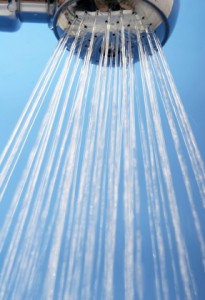 How you use your bathroom can cut greenhouse gas emissions in three ways:
How you use your bathroom can cut greenhouse gas emissions in three ways:
- Use less water. It takes energy to clean, filter and pump water and sewage.
- Less hot water. Water heaters are one of the most energy-costly appliances in a home. (1)
- The products we use in our bathrooms can be more climate-friendly. Just keep production, transport and waste (all “invisible” emissions to the average homeowner) in mind when choosing bathroom supplies.
Here are some tips for climate-friendly choices you can make in your bathroom.
Saving water
Showerhead – Install a low-flow shower head. Water-efficient, or low-flow, showerheads are designed to provide a satisfying shower at a much reduced flow rate.
Older showerheads deliver as much as 19 to 38 litres (5 to 10 gallons) of water per minute. (2) Water efficient showerheads deliver 10 litres (2.5 gallons) per minute or less at a standard water pressure. (3)
Switch the water off to save water while shaving or lathering.
Cold rinse – Rinse your hair with cold water. The less hot water used, the more energy and GHG emissions saved. A cold-water rinse is healthier for hair (and skin), too.
Brushing teeth – Turn the tap off as you brush your teeth. See how little water it actually takes to brush your teeth.
Washcloth – Use a washcloth to remove makeup. Cotton balls, tissues and disposable facecloths all require resources, energy and chemicals to produce – only to end up in a landfill after one use.
Towels – Use towels more than once. Towels are made to be re-used. Don’t toss them in the laundry after one shower or hand-washing session (you are clean)!
Taps – Install an aerator on your bathroom tap. In addition to saving energy and water, the “foamier” water that comes from faucet aerators wets objects better than water from a faucet with no aerator, which tends to bounce off the object rather than thoroughly wetting it. (4)
Toilet – Buy a low-flush toilet. Toilets account for 25 to 50% of total household water consumption. Older toilets use between 15 and 38 litres (4 – 10 gallons) per flush. New models use 6 litres (1.6 gallons) or less per flush, cutting the water use by 60 to 80 percent. (5)
Existing toilet – New toilet not in the budget? Place a plastic bottle full of water in your toilet tank. Reduce your flush volume by a litre (or two) while re-using plastic pop bottles. Or adjust the float in the toilet tank so the tank fills with less water after flushing.
Plunger – Buy a plunger. Most household clogs – especially in the toilet – can be fixed with a plunger. Drain cleaners are so toxic and corrosive that they cannot be discarded with your regular garbage. They can’t be re-used either.
Products
Toilet paper – Use toilet paper made from recycled fibre. Recycled toilet paper is NOT made from used toilet paper. It is made from recycled paper. Softer than earlier versions, the newer recycled bathroom tissue is nearly indistinguishable from the regular tree-gobbling stuff.
Toilet cleaners – Skip the cleans-every-single-time-you-use-the-loo toilet cleaners. With these cleaners, harsh chemicals are released into the water system every time you flush as well. Do we really need to clean the porcelain after every visit? No. For a quick freshening, simply sprinkle baking soda in the bowl and swish with the brush. Nothing toxic, nothing corrosive.
Soaps and lotions – Choose unscented soaps and lotions. Plain products are just as effective as scented ones. It takes additional energy, water, chemicals and the production of greenhouse gas emissions to create a chemical scent. It takes another industrial step to add it to bathroom products.




